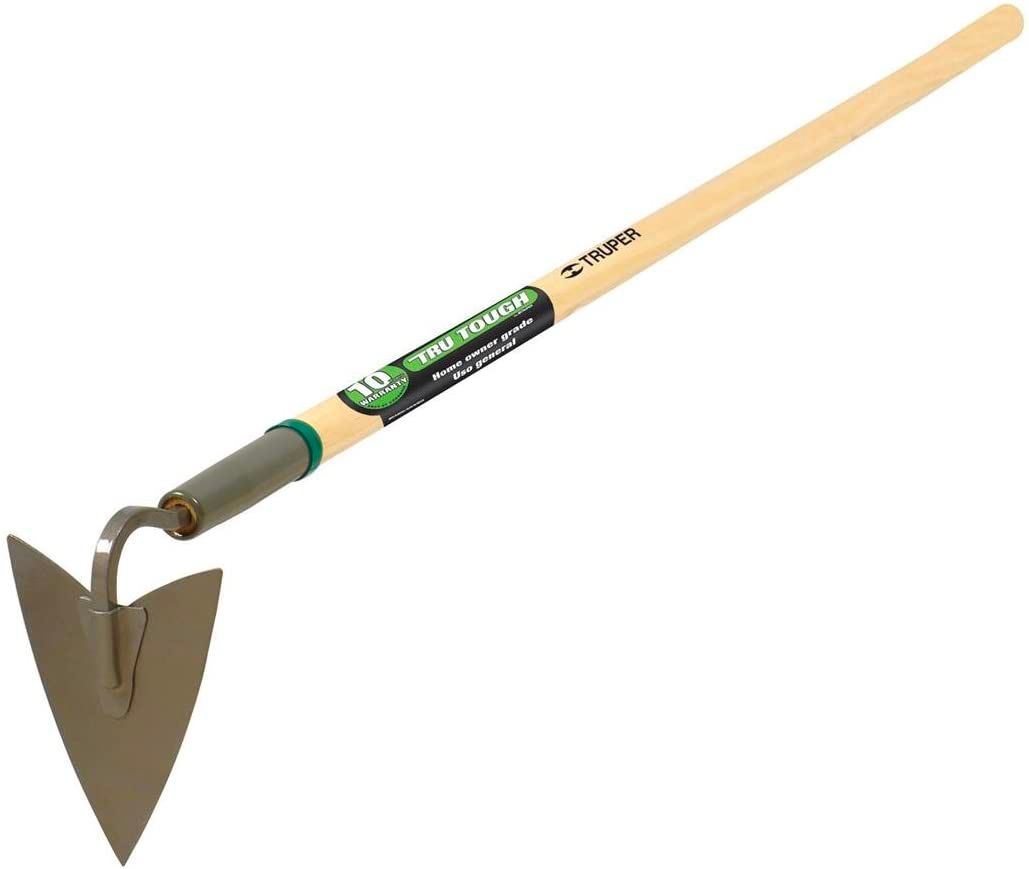Blog
Hoe Gardening Tools: Cultivating Your Garden with Precision
Published
8 months agoon
By
admin
. Introduction
- A Brief Overview of Gardening Tools
- Importance of Choosing the Right Tools
II. The Evolution of Hoe Gardening Tools
- Historical Roots
- Modern Innovations
III. Types of Hoe Gardening Tools
- Standard Hoes
- Warren Hoes
- Scuffle Hoes
- Dutch Hoes
IV. Choosing the Right Hoe for Your Garden
- Consideration of Soil Types
- Garden Size Matters
- Ergonomics and Handle Length
V. Proper Hoeing Techniques
- Correct Body Posture
- Effective Weed Removal
- Avoiding Damage to Plants
VI. Maintaining Your Hoe
- Cleaning and Sharpening Tips
- Storage Practices
VII. Advantages of Using Hoe Gardening Tools
- Time Efficiency
- Versatility in Garden Tasks
- Eco-Friendly Practices
VIII. Common Mistakes to Avoid
- Improper Hoe Selection
- Overlooking Maintenance
- Incorrect Hoeing Techniques
IX. Real-life Success Stories
- Testimonials from Experienced Gardeners
X. Tips for Beginners
- Starting with the Basics
- Seeking Guidance from Experts
XI. Environmental Impact of Hoe Gardening
- Sustainable Gardening Practices
- Reducing Carbon Footprint
XII. Addressing Challenges in Hoe Gardening
- Dealing with Tough Weeds
- Adapting to Different Soil Conditions
XIII. Frequently Asked Questions (FAQs)
- What is the best type of hoe for a beginner?
- How often should I sharpen my gardening hoe?
- Can hoes be used for purposes other than weeding?
- Are electric hoes a better option?
- How do I choose the right handle length for my hoe?
XIV. Conclusion
- Recap of Hoe Gardening Benefits
- Encouragement for Readers to Try Hoe Gardening
Hoe Gardening Tools: Cultivating Your Garden with Precision
Introduction
Hoe Gardening Tools, Gardening is a timeless hobby that brings joy and rewards to those who embrace it. Among the myriad of tools available to gardeners, the humble hoe stands out as a versatile and essential implement. In this article, we will explore the world of hoe gardening tools, from their historical roots to modern innovations, guiding you through choosing the right one for your garden and imparting valuable tips for effective use.
The Evolution of Hoe Gardening Tools
Historical Roots Hoes have been a staple in agriculture for centuries, with ancient civilizations using rudimentary forms of this tool for cultivating the soil. The evolution from handheld wooden implements to the diverse array of materials and designs available today is a testament to human ingenuity in gardening.
Modern Innovations Contemporary hoe gardening tools have undergone significant advancements. Materials such as stainless steel and carbon fiber have replaced traditional wood, offering durability and lightness. Innovative designs cater to specific gardening needs, ensuring efficiency and ease of use.
Types of Hoe Gardening Tools
Standard Hoes These are the traditional hoes with a flat, rectangular blade ideal for breaking up soil and removing weeds. They come in various sizes, allowing for customization based on the gardener’s preferences.
Warren Hoes Designed with a triangular blade, warren hoes are excellent for precision work in tight spaces. They are particularly useful for cultivating between plants without causing damage.
Scuffle Hoes Also known as stirrup hoes, these tools have a loop-shaped blade that easily glides through the soil, making them perfect for weeding and cultivating larger areas with minimal effort.
Dutch Hoes With a sharp, angled blade, Dutch hoes excel at cutting weeds just below the soil surface. Their push-and-pull motion makes them effective for maintaining weed-free rows.
Choosing the Right Hoe for Your Garden
Consideration of Soil Types Different hoes cater to various soil types. Understanding your garden’s soil composition is crucial for selecting the right hoe that maximizes efficiency and minimizes effort.
Garden Size Matters For smaller gardens, a compact hoe might be preferable, while larger plots may benefit from a wider-bladed option. Matching the hoe size to your garden’s dimensions ensures optimal results.
Ergonomics and Handle Length Comfort matters, especially during extended gardening sessions. Choosing a hoe with the right handle length and ergonomic design reduces strain on your body and enhances overall efficiency.
Proper Hoeing Techniques
Correct Body Posture Maintaining a proper posture while hoeing is essential to prevent strain and injury. Bend your knees, keep your back straight, and use the strength of your legs rather than your back for effective hoeing.
Effective Weed Removal Hoeing is a powerful weed control method. By skimming the surface of the soil with your hoe, you can easily cut down young weeds before they have a chance to establish themselves.
Avoiding Damage to Plants Precision is key when hoeing around delicate plants. Taking care to navigate around the base of your plants ensures you reap the benefits of weeding without harming your crops.
Maintaining Your Hoe
Cleaning and Sharpening Tips Regular cleaning and sharpening prolong the life of your hoe. Remove soil and debris after each use, and sharpen the blade as needed. A well-maintained hoe ensures efficient and clean cuts.
Storage Practices Proper storage prevents rust and damage. Hang your hoe or store it in a dry place to maintain its condition between uses.
Advantages of Using Hoe Gardening Tools
Time Efficiency Hoeing is a quick and effective way to tackle weeds and cultivate soil, saving you time and effort in the long run.
Versatility in Garden Tasks From weeding to soil preparation, hoes are versatile tools that can handle multiple gardening tasks, making them a valuable addition to any gardener’s toolkit.
Eco-Friendly Practices Reducing the need for chemical weed control, hoe gardening promotes eco-friendly practices, contributing to a healthier environment.
Common Mistakes to Avoid
Improper Hoe Selection Choosing the wrong hoe for your garden can lead to inefficiency and frustration. Take the time to understand your garden’s needs and select the appropriate hoe for the job.
Overlooking Maintenance A neglected hoe is less effective and can be more challenging to use. Regular cleaning and maintenance ensure your hoe remains a reliable companion in your gardening endeavors.
Incorrect Hoeing Techniques Hoeing too deeply or at the wrong angle can damage plant roots and disturb the soil structure. Understanding the proper techniques is vital for successful hoe gardening.
Real-life Success Stories
Testimonials from Experienced Gardeners Gardeners who have embraced hoe gardening share their success stories. From reclaiming overgrown plots to maintaining pristine flower beds, these testimonials highlight the transformative power of hoeing.
Tips for Beginners
Starting with the Basics For beginners, start with a standard hoe and practice in a small area. As you gain confidence and experience, you can explore other types of hoes and advanced techniques.
Seeking Guidance from Experts Don’t hesitate to seek advice from experienced gardeners or join local gardening groups. Learning from others’ experiences can fast-track your journey to becoming a skilled hoe gardener.
Environmental Impact of Hoe Gardening
Sustainable Gardening Practices Hoe gardening aligns with sustainable practices by minimizing the use of chemical weed control and promoting natural soil cultivation methods.
Reducing Carbon Footprint By adopting manual hoeing methods, gardeners contribute to a lower carbon footprint compared to the manufacturing and use of power tools. Hoe gardening is an eco-conscious choice.
Addressing Challenges in Hoe Gardening
Dealing with Tough Weeds Some weeds may prove challenging, but with the right hoe and techniques, even the toughest opponents can be effectively managed.
Adapting to Different Soil Conditions Each garden presents unique soil challenges. Adapting your hoeing techniques to suit the soil conditions ensures optimal results in various environments.
Frequently Asked Questions (FAQs)
- What is the best type of hoe for a beginner?
- The standard hoe is an excellent choice for beginners due to its versatility and ease of use.
- How often should I sharpen my gardening hoe?
- Sharpen your hoe as needed, depending on usage. Regularly inspect the blade, and sharpen if it appears dull.
- Can hoes be used for purposes other than weeding?
- Yes, hoes are versatile tools suitable for tasks like soil cultivation, trenching, and creating furrows.
- Are electric hoes a better option?
- Electric hoes may have their merits, but manual hoes offer greater control and are often more environmentally friendly.
- How do I choose the right handle length for my hoe?
- Select a handle length that allows for comfortable use without excessive bending. Consider the height of the gardener and the size of the garden.
Conclusion
In conclusion, hoe gardening tools are indispensable for any gardener seeking efficiency, versatility, and eco-conscious practices. From the historical roots to modern innovations, the diverse types of hoes cater to various gardening needs. By adopting proper techniques and maintenance practices, you can unlock the full potential of hoe gardening and enjoy a flourishing garden. Embrace the simplicity and effectiveness of hoe gardening—it’s a journey that promises bountiful rewards.
You may like
Blog
Kashito_Toto: Exploring the Rise of a Modern Digital Icon
Published
12 hours agoon
July 26, 2024By
john vick
What is Kashito_Toto?
Kashito_Toto is a digital entity that seamlessly blends virtual art, interactive media, and cutting-edge technology to create a distinctive online presence. Originating from the convergence of digital art and social media, Kashito_Toto has grown from a niche concept into a recognizable figure in the digital landscape.
The Genesis of Kashito_Toto
The origins of Kashito_Toto can be traced back to early experiments in virtual art and avatar creation. Combining elements from Japanese pop culture, digital art, and futuristic aesthetics, Kashito_Toto emerged as a persona characterized by its unique visual style and interactive capabilities. The name itself reflects a fusion of cultural references and modern digital trends, hinting at a blend of traditional and futuristic elements.
Visual and Artistic Identity
At the heart of Kashito_Toto’s appeal is its striking visual identity. The persona is often depicted with a blend of vibrant colors, futuristic elements, and anime-inspired features. This aesthetic not only captures attention but also resonates with a broad audience, particularly those engaged with digital art and Japanese pop culture.
Kashito_Toto’s visual style is characterized by:
- Vivid Colors: The use of bright, eye-catching colors that create a sense of dynamism and energy.
- Futuristic Elements: Incorporating sci-fi motifs and technology-inspired designs.
- Anime Influence: Features reminiscent of Japanese anime and manga, including exaggerated expressions and stylized character designs.
Interactive and Immersive Experiences
One of the defining aspects of Kashito_Toto is its focus on interactivity. Unlike static digital personas, Kashito_Toto engages audiences through immersive experiences and interactive media. These experiences include:
- Virtual Reality (VR) and Augmented Reality (AR): Kashito Toto has been integrated into VR and AR environments, allowing users to interact with the persona in a 3D space. These technologies enhance the sense of immersion and engagement.
- Interactive Art Installations: Digital art installations featuring Kashito_Toto allow users to explore and interact with virtual art, creating a personalized experience.
- Social Media Engagement: Kashito Toto leverages social media platforms to interact with fans, share updates, and participate in online communities. This presence helps build a strong connection with the audience.
Cultural and Technological Impact
Kashito_Toto represents a fusion of art and technology, reflecting broader trends in digital culture. Its rise highlights several key impacts on contemporary media and technology:
1. Blending Art and Technology
Kashito_Toto exemplifies the merging of artistic expression with technological innovation. The use of VR, AR, and interactive media showcases how technology can enhance artistic experiences and create new forms of engagement. This blending of disciplines is indicative of a broader trend where traditional art forms are increasingly integrated with digital technologies.
2. The Evolution of Digital Personas
The success of Kashito Toto reflects the growing influence of digital personas in shaping online culture. These personas, often created and managed by individuals or teams, can build substantial followings and become influential figures in their own right. Kashito Toto’s rise underscores the potential for digital characters to impact entertainment, social media, and beyond.
3. Cultural Hybridization
Kashito Toto’s aesthetic and cultural references highlight the hybrid nature of modern digital culture. By drawing on elements from Japanese pop culture, sci-fi, and contemporary art, Kashito Toto embodies a globalized approach to cultural expression. This hybridization reflects the interconnected nature of today’s digital world, where influences and inspirations cross geographical and cultural boundaries.
The Future of Kashito_Toto
As a digital icon, KashitoToto’s trajectory is shaped by ongoing developments in technology and digital culture. Future possibilities include:
1. Expansion into New Media
Kashito Toto may continue to expand into new media formats, including gaming, film, and virtual events. Collaborations with other artists and creators could further enhance its visibility and impact.
2. Advancements in Technology
As technology evolves, so too will the ways in which Kashito_Toto interacts with its audience. Advances in VR, AR, and artificial intelligence could offer even more immersive and personalized experiences.
3. Cultural Influence
Kashito_Toto may increasingly influence cultural trends and digital art movements. Its success could inspire new digital personas and innovative approaches to combining art and technology.
Conclusion
Kashito_Toto represents a fascinating intersection of art, technology, and digital culture. Its rise as a modern digital icon highlights the evolving landscape of online media and the growing influence of virtual personas. By blending vibrant visuals, interactive experiences, and cultural references, Kashito_Toto has carved out a unique niche in the digital world.
As technology and culture continue to evolve, the story of Kashito Toto will likely serve as a compelling case study in the power of digital innovation and the transformative potential of modern media.
Blog
Asseturi: Understanding and Leveraging Financial Assets for Growth
Published
13 hours agoon
July 26, 2024By
john vick
What Are Assets?
At its core, an Asseturi is any resource owned by an individual or organization that is expected to provide future economic benefits. Assets are essential for generating income, supporting growth, and achieving financial stability. They can be categorized into various types, each with distinct characteristics and implications for financial strategy.
1. Types of Asseturi
a. Tangible Asseturi
Tangible assets are physical and measurable resources. These include:
- Real Estate: Properties such as land, buildings, and homes. Real estate investments can offer rental income and appreciation in value.
- Machinery and Equipment: Tools and machinery used in manufacturing and production processes.
- Vehicles: Cars, trucks, and other transportation means that contribute to business operations.
b. Intangible Assets
Intangible Asseturi lack physical substance but hold significant value. Examples include:
- Intellectual Property: Patents, trademarks, and copyrights that provide a competitive edge and potential revenue streams.
- Goodwill: The value derived from a company’s reputation, customer relationships, and brand strength.
- Software: Proprietary software or systems developed for business operations.
c. Financial Asseturi
Financial assets represent value in the form of financial instruments. These encompass:
- Cash and Cash Equivalents: Liquid Asseturi like cash, bank deposits, and short-term investments.
- Stocks and Bonds: Equity securities (stocks) and debt instruments (bonds) that provide returns through dividends or interest.
- Derivatives: Financial contracts whose value depends on underlying Asseturi, including options and futures.
d. Investments
Investments are assets acquired with the expectation of future returns. They include:
- Mutual Funds and ETFs: Investment funds that pool money from various investors to invest in a diversified portfolio.
- Real Estate Investment Trusts (REITs): Companies that own, operate, or finance income-producing real estate.
The Role of Assets in Financial Strategy
Assets play a pivotal role in both personal and business finance. Their management and optimization are crucial for achieving financial goals and ensuring stability.
1. Wealth Accumulation
Asseturi are fundamental to building wealth. By investing in various asset classes, individuals and businesses can accumulate wealth over time. Diversification across asset types helps spread risk and maximize potential returns. For example, owning a mix of stocks, real estate, and bonds can mitigate the impact of market fluctuations.
2. Income Generation
Assets can generate ongoing income through interest, dividends, or rental income. For instance:
- Rental Properties: Real estate investments can provide a steady stream of rental income.
- Dividend Stocks: Equities in companies that pay dividends offer regular income to shareholders.
- Interest-bearing Accounts: Savings accounts and bonds generate interest payments.
3. Financial Stability
A well-managed portfolio of assAsseturiets contributes to financial stability. Liquidity, or the ease of converting assets into cash without significant loss of value, is crucial. Maintaining a balance between liquid assets (like cash) and illiquid assets (like real estate) ensures that one can meet short-term obligations while investing for long-term growth.
4. Growth and Expansion
For businesses, assets are instrumental in growth and expansion. Investing in new technology, expanding facilities, or acquiring other companies requires substantial assets. Strategic allocation of resources toward growth initiatives can enhance competitive advantage and drive profitability.
Asset Management: Best Practices
Effective asset management involves making informed decisions about acquiring, holding, and disposing of Asseturi. Key practices include:
1. Asset Allocation
Asset allocation is the process of distributing investments among different asset classes to balance risk and reward. A diversified portfolio might include a mix of equities, fixed income, and alternative investments, tailored to the investor’s risk tolerance and financial goals.
2. Regular Review and Rebalancing
Regularly reviewing and rebalancing a portfolio ensures that it remains aligned with financial goals and market conditions. Rebalancing involves adjusting the proportions of different assets to maintain the desired risk-return profile.
3. Risk Management
Identifying and managing risks associated with assets is crucial. This involves assessing potential threats such as market volatility, economic downturns, and changes in interest rates. Risk management strategies include diversification, hedging, and maintaining adequate liquidity.
4. Performance Monitoring
Monitoring the performance of assets helps in evaluating their contribution to overall financial goals. Performance metrics such as return on investment (ROI), yield, and capital gains provide insights into the effectiveness of asset management strategies.
Case Studies: Assets in Action
1. Personal Finance
Consider the example of a retiree managing their savings. A balanced portfolio might include a mix of dividend-paying stocks, bonds, and real estate investments. This approach provides a steady income stream while preserving capital. Regularly reviewing the portfolio and adjusting allocations based on market conditions and personal needs ensures financial security throughout retirement.
2. Corporate Finance
A technology startup may focus on acquiring intellectual property and technology assets. By investing in research and development, the company builds a strong portfolio of patents and proprietary software. These assets enhance the company’s market position and attract venture capital investment. As the company grows, it may reinvest profits into expanding its facilities and acquiring additional technology.
Conclusion
Asseturi are the cornerstone of financial strategy, offering a range of benefits from wealth accumulation to income generation and stability. Understanding the different types of Asseturi and how to manage them effectively is crucial for both individuals and businesses. By employing best practices in asset allocation, risk management, and performance monitoring, one can optimize their asset base to achieve financial goals and navigate economic uncertainties.
In the ever-evolving financial landscape, staying informed about asset management principles and adapting strategies to changing conditions will pave the way for sustained growth and success. Whether for personal finance or corporate strategy, the thoughtful management of assets remains a vital element in the pursuit of economic prosperity.
Blog
Suwuianna: Unveiling the Mysteries of an Ancient Civilization
Published
2 weeks agoon
July 16, 2024By
robert log
Historical Context and Discovery
The civilization of Suwuianna flourished in what is now the southeastern region of the Mediterranean basin, dating back to around 3000 BCE. It was first discovered in the late 19th century by archaeologists who stumbled upon its ruins while excavating for other known civilizations. Initial findings included pottery shards, remnants of grand structures, and inscriptions in an undeciphered script, sparking curiosity and intrigue within the archaeological community.
Geographic and Environmental Factors
Suwuianna’ geographic location played a crucial role in its development. Situated near fertile river valleys and coastal plains, the region provided abundant resources for agriculture and trade. The temperate climate, coupled with rich soil and access to water, allowed the Suwuiana people to cultivate a variety of crops, supporting a stable and growing population. Additionally, the proximity to the sea facilitated maritime trade, connecting Suwuinna with other contemporary civilizations and fostering cultural exchanges.

Political and Social Structure
The political structure of Suwianna was characterized by a centralized form of government, possibly a monarchy or a theocratic state, as inferred from the grandiose palaces and temples discovered. The society appeared to be highly stratified, with a clear hierarchy of rulers, priests, artisans, and laborers. The ruling class likely held both political and religious authority, overseeing the administration, economic activities, and religious ceremonies.
The social fabric of Suwuianna was complex and multifaceted. Evidence suggests that family units were the basic social structure, with extended families living in close-knit communities. The division of labor was well-defined, with specialized roles in agriculture, craftsmanship, trade, and religious duties. This specialization contributed to the society’s overall prosperity and advancement.
Cultural and Artistic Achievements
Suwuianna’s cultural and artistic achievements are among the most fascinating aspects of the civilization. Their artistry is evident in the intricate pottery, jewelry, and sculptures unearthed from archaeological sites. The Suwuanna people were adept at working with various materials, including clay, stone, metal, and precious gems. Their craftsmanship not only served functional purposes but also had significant aesthetic and symbolic value.
One of the most remarkable artistic achievements of Suwuianna is their architectural prowess. The remains of grand palaces, temples, and public buildings showcase advanced engineering and construction techniques. The use of precise stone masonry, complex structural designs, and decorative elements like frescoes and reliefs indicates a high level of architectural sophistication. These structures served as centers of administration, worship, and social gatherings, reflecting the civilization’s cultural and religious priorities.
Language and Writing
The script of Suwuiana remains one of the most enigmatic aspects of the civilization. Inscriptions found on pottery, monuments, and artifacts suggest a complex writing system, but it has yet to be fully deciphered. The script appears to be logographic or syllabic, similar to other ancient writing systems like cuneiform or hieroglyphs. Efforts to decode the script have been ongoing, with scholars comparing it to known languages and scripts of the region in hopes of unlocking its secrets.
The inability to fully understand the Suwuianna script has posed challenges in comprehending their literature, administrative records, and religious texts. However, the visual and contextual clues provided by the inscriptions offer glimpses into their language and communication methods. It is hoped that future discoveries and advancements in deciphering techniques will shed more light on this aspect of Suuianna’s civilization.
Religion and Spirituality

Religion played a central role in the daily lives of the Suwuianna people. Archaeological evidence points to a polytheistic belief system, with a pantheon of gods and goddesses governing various aspects of life and nature. Temples dedicated to these deities were focal points of religious activity, where priests conducted rituals, sacrifices, and ceremonies to appease the gods and seek their favor.
The Suwuianna cosmology and mythology, though not fully understood due to the undeciphered script, can be partially reconstructed from artistic depictions and parallels with neighboring cultures. Themes of creation, fertility, and the afterlife appear to have been significant, with elaborate burial practices indicating a belief in an afterlife. Tombs and burial sites often contained grave goods, such as pottery, tools, and personal items, suggesting that the Suwuianna people prepared for a journey beyond death.
Economic Activities and Trade
Suwuianna’s economy was diverse and dynamic, driven by agriculture, craftsmanship, and trade. The fertile lands supported the cultivation of grains, fruits, vegetables, and livestock, providing sustenance for the population and surplus for trade. The production of goods such as pottery, textiles, and metalwork was highly developed, with artisans producing items for both domestic use and export.
Trade was a vital component of Suwuianna’s economy, facilitated by its strategic location and access to the sea. Archaeological findings indicate extensive trade networks connecting Suwuianna with other contemporary civilizations in the Mediterranean and beyond. Items such as pottery, metal tools, and luxury goods have been found in distant regions, testifying to the reach and influence of Suwuianna’s trade relationships. These interactions not only boosted the economy but also contributed to cultural exchanges and the spread of ideas.
Decline and Legacy
The decline of Suwuianna remains a topic of debate among scholars. Various factors, including environmental changes, resource depletion, internal strife, and external invasions, could have contributed to the civilization’s eventual downfall. By around 1000 BCE, evidence suggests that Suwuianna’s cities and structures were abandoned, and the civilization faded into obscurity.
Despite its decline, the legacy of Suwuianna endures. The civilization’s artistic, architectural, and cultural contributions have left a lasting impact on subsequent cultures and societies in the region. Elements of Suwuianna’s craftsmanship, architectural styles, and religious practices can be seen in later Mediterranean civilizations. Moreover, the ongoing efforts to study and understand Suwuianna continue to enrich our knowledge of ancient history and the interconnectedness of early human societies.
Modern Discoveries and Research
The study of Suwuianna is an evolving field, with new discoveries continually reshaping our understanding of this ancient civilization. Advances in technology, such as remote sensing, ground-penetrating radar, and digital imaging, have revolutionized archaeological research, enabling scholars to uncover hidden structures and artifacts without intrusive excavation. These methods have led to the identification of previously unknown sites and the reevaluation of existing ones.
Collaboration among international teams of archaeologists, linguists, historians, and scientists has also accelerated the pace of research. Multidisciplinary approaches are helping to piece together the puzzle of Suwuianna, from deciphering the script to understanding the environmental context of their settlements. The integration of scientific techniques, such as isotope analysis and radiocarbon dating, is providing more accurate timelines and insights into the daily lives of the Suwuianna people.
The Future of Suwuianna Studies
As research continues, the future of Suwuianna studies holds great promise. Each new discovery brings us closer to unraveling the mysteries of this ancient civilization and appreciating its contributions to human history. Efforts to decipher the script remain a high priority, as unlocking the language could open up a wealth of knowledge about Suwuianna’s governance, economy, religion, and daily life.
Public interest and support for archaeological research are also crucial for the continued exploration of Suwuianna. Educational programs, museum exhibitions, and media coverage can raise awareness and generate enthusiasm for this fascinating civilization. Engaging the public in the preservation and study of Suwuianna’s heritage ensures that the legacy of this ancient society is not forgotten.
Conclusion
The civilization of Suwuianna, though largely lost to the sands of time, continues to captivate and inspire. Through the diligent efforts of archaeologists and researchers, we are gradually uncovering the rich tapestry of Suwuianna’s history, culture, and achievements. From their advanced architecture and intricate artistry to their complex social structures and economic networks, Suwuianna represents a remarkable chapter in the story of human civilization.
As we delve deeper into the mysteries of Suwuianna, we gain not only a greater appreciation for this ancient society but also a broader understanding of our shared human heritage. The legacy of Suwuianna reminds us of the resilience, creativity, and interconnectedness of early human civilizations, offering valuable lessons and insights for our world today.
Trending
-

 Business7 months ago
Business7 months agoQuantity TBD on Amazon: €ководство
-

 Business3 months ago
Business3 months agoIntegremos: Weaving Together the Fabric of Connection
-

 Tech8 months ago
Tech8 months agoDesgrabador
-

 Business8 months ago
Business8 months agoGetting Started With Hqpotner
-

 News7 months ago
News7 months agoWTOV Channel 9 Revealed: The Untold Stories You Never Knew
-

 News8 months ago
News8 months agoHow To Wear Brıston
-

 Blog8 months ago
Blog8 months agoAmerican Express Work from Home Jobs
-

 News8 months ago
News8 months agoWhat Is Zeolítica?
